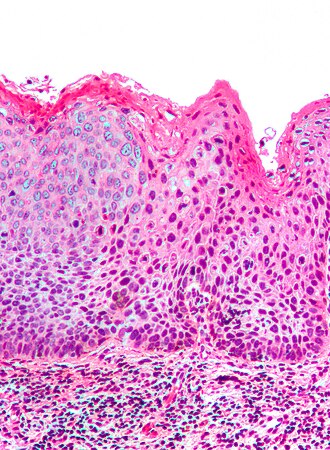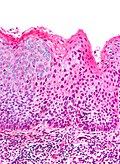Classic vulvar intraepithelial neoplasia
Jump to navigation
Jump to search
| Classic vulvar intraepithelial neoplasia | |
|---|---|
| Diagnosis in short | |
 Classic vulvar intraepithelial neoplasia. H&E stain. | |
|
| |
| Synonyms | usual vulvar intraepithelial neoplasia |
|
| |
| LM | increased NC ratio, multinucleation, lack of maturation to surface (not very useful -- unlike in the cervix), +/-non-basal mitoses, +/-atypical mitoses |
| LM DDx | vulvar squamous cell carcinoma, condyloma acuminatum, dermatomycosis |
| IHC | p16 +ve, p53 -ve, Ki-67 - suprabasal staining |
| Site | vulva |
|
| |
| Associated Dx | vulvar squamous cell carcinoma, other HPV lesions |
| Clinical history | young women |
| Prevalence | uncommon |
Classic vulvar intraepithelial neoplasia, abbreviated classic VIN, is a pre-neoplastic lesion of the vulva strongly associated with the human papilloma virus.
It is also known as usual vulvar intraepithelial neoplasia, abbreviated uVIN.[1] Despite being called "usual", it is less common than the other form of vulvar intraepithelial neoplasia (differentiated vulvar intraepithelial neoplasia).
General
Epidemiology:
- Classic VIN, like CIN, is associated with HPV and seen in younger women.
- May be multifocal, i.e. associated with cervical (CIN) or vaginal (VAIN) lesions;[2] multifocality has a strongly association with immunosuppression.[3]
Classic VIN is graded like cervical pre-cancerous lesions:
- VIN I.
- DDx: condyloma acuminatum.[4]
- Uncommon.
- VIN II.
- Not common.
- VIN III.
- Commonly seen.
Microscopic
Features:
- Increased NC ratio.
- Multinucleation.
- Lack of maturation to surface (not very useful -- unlike in the cervix).[5]
- May have "vertical streaming" - the long axis of the cells are perpendicular to the free surface & basement membrane.
- Apical mitoses.
DDx:
- Condyloma acuminatum.
- Vulvar squamous cell carcinoma, esp. warty type.
- Extramammary Paget disease.
- Dermatomycosis (fungal infection) - esp. candidiasis.
Images
IHC
- Classic VIN: p16 +ve, p53 -ve.
- Differentiated VIN: p16 -ve, p53 +ve.[7]
Note:
- p16 can be thought of as a poor man's HPV test.
Sign out
VIN I
VULVA, BIOPSY: - CLASSIC VULVAR INTRAEPITHELIAL NEOPLASIA (VIN) I (MILD DYSPLASIA). - NEGATIVE FOR INVASIVE MALIGNANCY.
VIN III
VULVA, EXCISION: - CLASSIC VULVAR INTRAEPITHELIAL NEOPLASIA (VIN) III (SEVERE DYSPLASIA) WITH FOCAL ULCERATION. - MARGIN FOCALLY POSITIVE FOR VIN III. - NEGATIVE FOR INVASIVE MALIGNANCY.
See also
References
- ↑ Reyes, MC.; Cooper, K. (Jan 2014). "An update on vulvar intraepithelial neoplasia: terminology and a practical approach to diagnosis.". J Clin Pathol. doi:10.1136/jclinpath-2013-202117. PMID 24399036.
- ↑ Pai, K.; Pai, S.; Gupta, A.; Rao, P.; Renjhen, P. (Oct 2006). "Synchronous vulvar intraepithelial neoplasia (VIN) of warty type and cervical intraepithelial neoplasia (CIN): case report.". Indian J Pathol Microbiol 49 (4): 585-7. PMID 17183865.
- ↑ Ait Menguellet, S.; Collinet, P.; Houfflin Debarge, V.; Nayama, M.; Vinatier, D.; Leroy, JL. (May 2007). "Management of multicentric lesions of the lower genital tract.". Eur J Obstet Gynecol Reprod Biol 132 (1): 116-20. doi:10.1016/j.ejogrb.2006.04.011. PMID 16713062.
- ↑ Rufforny, I.; Wilkinson, EJ.; Liu, C.; Zhu, H.; Buteral, M.; Massoll, NA. (Apr 2005). "Human papillomavirus infection and p16(INK4a) protein expression in vulvar intraepithelial neoplasia and invasive squamous cell carcinoma.". J Low Genit Tract Dis 9 (2): 108-13. PMID 15870532.
- ↑ LAE. February 2009.
- ↑ 6.0 6.1 Kotsopoulos, IC.; Tampakoudis, GP.; Evaggelinos, DG.; Nikolaidou, AI.; Fytili, PA.; Kartsiounis, VC.; Gerasimidou, DK. (2011). "Implication of human papillomavirus-66 in vulvar carcinoma: a case report.". J Med Case Rep 5: 232. doi:10.1186/1752-1947-5-232. PMC 3150314. PMID 21702970. https://www.ncbi.nlm.nih.gov/pmc/articles/PMC3150314/.
- ↑ Pinto, AP.; Miron, A.; Yassin, Y.; Monte, N.; Woo, TY.; Mehra, KK.; Medeiros, F.; Crum, CP. (Mar 2010). "Differentiated vulvar intraepithelial neoplasia contains Tp53 mutations and is genetically linked to vulvar squamous cell carcinoma.". Mod Pathol 23 (3): 404-12. doi:10.1038/modpathol.2009.179. PMID 20062014.

